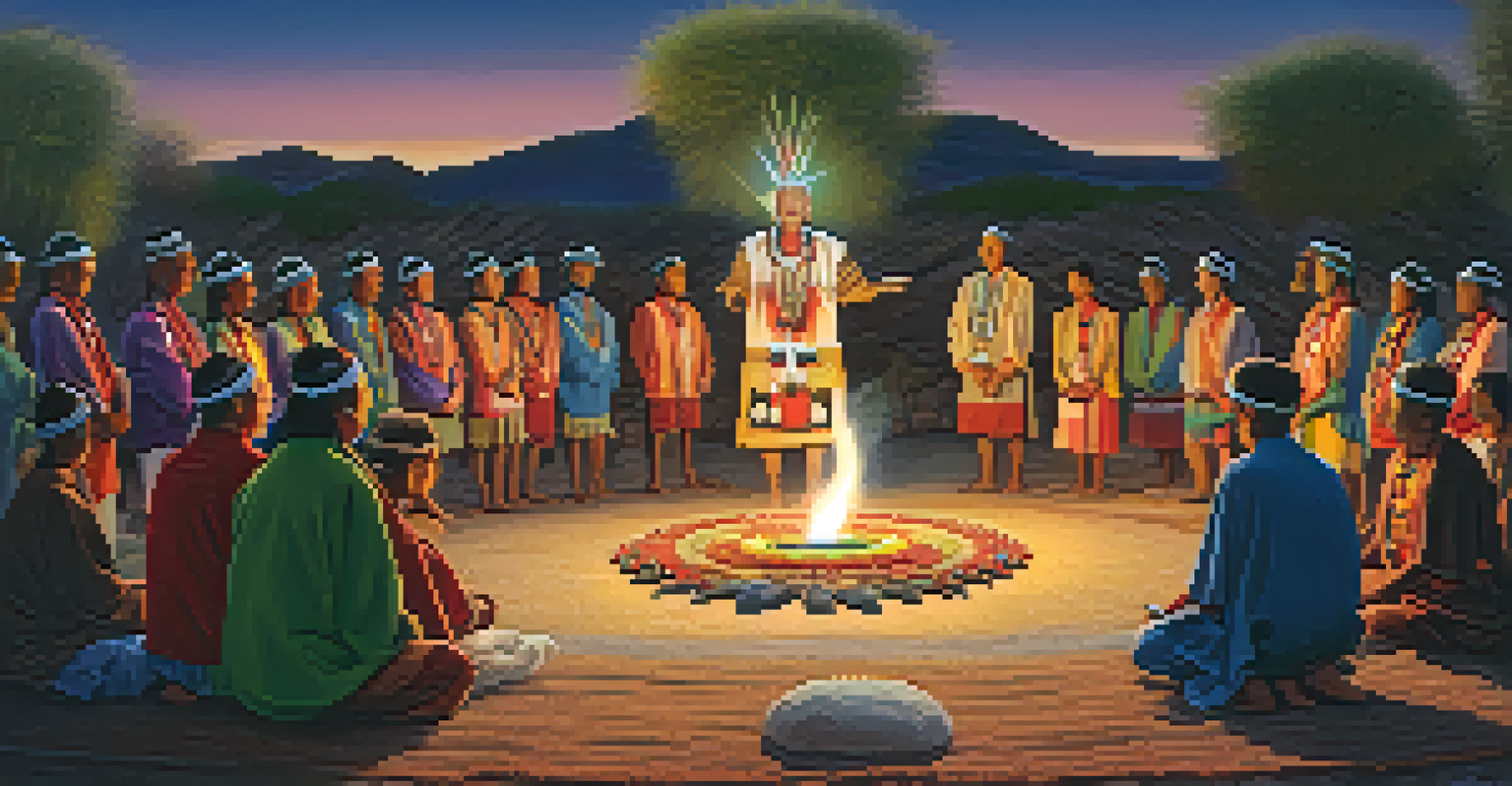Peyote Use and Its Influence on Gender Roles in Indigenous Cultures

Understanding Peyote: A Sacred Cactus in Culture
Peyote, a small cactus native to Mexico and the southwestern United States, has been used for centuries in various Indigenous cultures. This cactus is known for its psychoactive properties, primarily due to the compound mescaline. In these cultures, peyote is not just a plant but a vital part of spiritual practices and healing rituals. By engaging with peyote, individuals often seek to connect with the spiritual realm, which can influence their understanding of gender roles.
The use of peyote in ceremonies highlights its importance in fostering community ties and cultural identity.
The use of peyote in ceremonies, such as those conducted by the Native American Church, highlights its importance in fostering community ties and cultural identity. These gatherings often blur traditional gender roles, providing a space where both men and women can express their spirituality. In this way, peyote serves as a tool for exploring and sometimes redefining what it means to be male or female within these communities.
Furthermore, the spiritual experiences induced by peyote can lead to transformative insights about oneself and one's place in the world. This can challenge existing gender norms and encourage a more fluid understanding of identity. As participants navigate their spiritual journeys, they may find that peyote opens doors to new perspectives on gender and relationships.
Historical Perspectives on Gender and Peyote Use
Historically, the use of peyote has been intertwined with the social structures of Indigenous cultures. In many tribes, men were often seen as the primary spiritual leaders, tasked with conducting ceremonies and rituals. However, as peyote use became more widespread, women began to carve out their own spaces within these spiritual practices, leading to a shift in traditional gender dynamics.

In some cultures, women have taken on significant roles as healers and spiritual guides, particularly in peyote ceremonies. This shift not only empowered women but also challenged the patriarchal structures that had long dominated Indigenous societies. For instance, in certain tribes, women's insights during peyote rituals are now highly valued, creating a more balanced spiritual community.
Peyote's Role in Gender Fluidity
Peyote rituals encourage participants to transcend traditional gender boundaries, fostering a more fluid understanding of identity.
The transformation in gender roles is not just about the participation of women but also about the lessons learned from peyote experiences. As individuals share their visions and insights, they contribute to a communal understanding that can redefine roles and expectations. This evolution in gender perception reflects a broader trend of inclusivity within Indigenous cultures.
Peyote Rituals: A Space for Gender Fluidity
Peyote rituals often emphasize community and connection, which can lead to more fluid interpretations of gender. In these ceremonies, participants are encouraged to express their true selves, and this can transcend traditional gender boundaries. For many, the experience serves as a reminder that gender is not strictly binary but exists on a spectrum.
Gender roles are not fixed but can evolve over time, reflecting the interconnectedness that peyote symbolizes in Indigenous spirituality.
During peyote ceremonies, individuals may feel liberated from societal expectations tied to their gender. This liberation allows for a more authentic expression of identity, where roles are not confined to traditional male or female characteristics. Such experiences can foster greater acceptance of diverse gender identities within the community.
Moreover, the communal aspect of these rituals encourages dialogue about gender roles, promoting understanding and acceptance. As participants share their experiences, they often reshape the narrative around gender within their cultures, paving the way for a more inclusive approach that honors all identities.
Influence of Peyote on Modern Indigenous Gender Roles
In contemporary Indigenous communities, the influence of peyote continues to shape discussions around gender roles. As younger generations engage in peyote ceremonies, they bring fresh perspectives that reflect broader societal changes. This intergenerational exchange is crucial in evolving understandings of masculinity, femininity, and beyond.
Modern peyote ceremonies often incorporate elements of activism, addressing issues such as gender equality and LGBTQ+ rights within Indigenous contexts. By using peyote as a catalyst for dialogue, communities can confront historical injustices and work towards a more equitable future. These discussions often lead to a re-evaluation of what it means to be a man or a woman today.
Elders Shape Modern Gender Norms
Elders guide discussions on gender roles in peyote ceremonies, emphasizing the evolution of these roles within contemporary Indigenous cultures.
Furthermore, as Indigenous cultures adapt to changing societal norms, the role of peyote as a spiritual guide remains constant. This adaptability allows for a rich exploration of identity, encouraging individuals to embrace their authentic selves while honoring their cultural heritage.
The Role of Elders in Shaping Gender Perspectives
Elders play a pivotal role in guiding peyote ceremonies and the discussions surrounding gender roles within Indigenous cultures. Their wisdom is often sought to navigate the complexities of identity and spirituality in modern times. Elders can provide historical context to the use of peyote, helping younger generations understand its significance in shaping gender norms.
In many communities, elders encourage open dialogue about gender and spirituality, fostering an environment where all voices can be heard. This mentorship is essential in reinforcing the idea that gender roles are not fixed but can evolve over time. By sharing their experiences with peyote, elders help bridge the gap between tradition and contemporary understanding.
Additionally, elders often emphasize the importance of respect and balance in gender relations. Through their teachings, they can inspire a return to values that honor both masculinity and femininity, promoting harmony within the community. This holistic approach to gender roles reflects the interconnectedness that peyote symbolizes in Indigenous spirituality.
Case Studies: Peyote and Gender Roles in Specific Cultures
Examining specific case studies can provide deeper insights into how peyote affects gender roles across different Indigenous cultures. For instance, the Huichol people of Mexico view peyote as a sacred medicine that transcends gender distinctions. In their rituals, both men and women participate equally, sharing responsibilities and insights that reflect a collective spiritual journey.
Similarly, the Lakota Sioux have integrated peyote into their healing practices, where both genders play essential roles. Women, in particular, are recognized for their contributions as spiritual leaders, challenging traditional notions of male dominance. This balance fosters a sense of community that values contributions regardless of gender.
Case Studies Show Diverse Outcomes
Different Indigenous cultures exhibit unique ways in which peyote influences gender roles, reflecting their distinct spiritual practices and societal structures.
These case studies illustrate that while peyote has the power to influence gender roles, the outcomes can vary significantly across cultures. By respecting and understanding these differences, we gain a broader perspective on the transformative potential of peyote in shaping identity and societal structures.
Conclusion: The Ongoing Journey of Gender and Peyote
The exploration of peyote use and its influence on gender roles in Indigenous cultures reveals a dynamic interplay of tradition and modernity. As communities continue to engage with peyote, they also confront the evolving understanding of gender and identity. This journey is not just about the sacred cactus but also about the people who use it and the stories they share.
While peyote serves as a spiritual tool, it also acts as a mirror reflecting the complexities of gender roles in Indigenous societies. The conversations sparked by these experiences can lead to profound changes, encouraging individuals to embrace their unique identities while honoring their heritage. This duality enriches the cultural tapestry of Indigenous life.

Ultimately, the ongoing dialogue around peyote and gender roles highlights the importance of inclusivity and respect in all aspects of life. As we continue to learn from these traditions, we can foster a deeper understanding of the diverse identities that enrich our world.